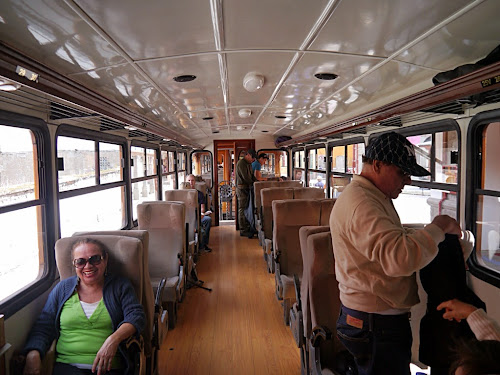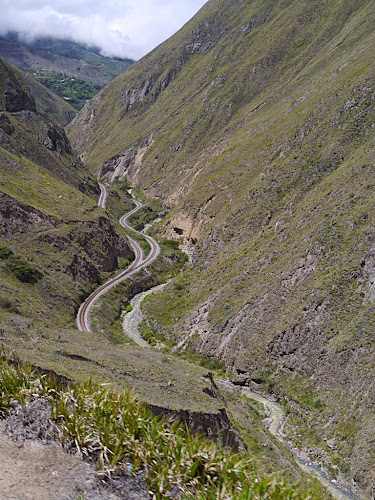To go almost anywhere from Guamote by bus, you have to walk down the hill to the Pan American highway and flag a bus going in the direction you want and hope that it's not full. If you're lucky, one will come soon and have room for you. If not, it can be along wait. Going to Alausí for the train ride, I waited for about a half hour. Not too bad. I got there well ahead of departure time, got a ticket and wandered around town until departure time.
I heard the strains of music coming from inside a big gymnasium as I was wandering around and poked my head inside. One of the players motioned me to come in and I listened to these guys rehearse this strange modern music for a while.
The train was half full, at the most, so the passengers could shift from side to side as the views changed.
 The train prior to modernization when passengers could ride on the roof to get away from the chickens and pigs, etc, that people packed along.
The train prior to modernization when passengers could ride on the roof to get away from the chickens and pigs, etc, that people packed along.Alausí is perched on the edge of a canyon and the views are beautiful as the train descends.
As billed, the engineering of this railway is quite astonishing. This is a quote from some web posting:
"Several plans and attempts were made to build the railway from Guayaquil to Quito, since 1860 until 1874, when the first locomotive reached Milagro.
But it was only in 1895, when Eloy Alfaro was president, that contacts were made with North American technicians Archer Harman and Edward Morely, representatives of an American company interested in the building of the "most difficult railway in the world" as it was called at that time. An agreement was reached, and "The Guayaquil and Quito Railway Company" started the construction in 1899.
The tracks finally reached a huge obstacle - an almost perpendicular wall of rock - called the "Devil's Nose". Many lives were shed in the building of what until now is called a masterpiece of railway engineering : a zig-zag carved out of the rock, which allows the train, by advancing and backing up, to reach the necessary height to the town of Alausí. The train finally reached Alausí in September 1902 and Riobamba in July 1905."
The name "Devils Nose" is in reference to the great numbers of people who died in the construction of the railway, mostly people brought from the Carribean.
It takes a little over an hour to arrive at the destination of Sibambe at the bottom of the canyon. Here things get a bit cheesy. The train pulls into the station and we are greeted by a troop of "indigenous" dancers whirling to loud canned music. We roll along a little further to a place where we can disembark to view and photo the Nariz unobstructed for a few minutes,
then back to the station for our included box lunch which was a bit overpriced. We had a hour and a half there, long enough to see the little museum, some native plants, a cafe with better food for sale and tip opportunities for the dancers.
Then back up the nose to Alausí where I had another forgetable lunch of, you guessed it: chicken, rice and french fries. Then the bus back to Guamote and that was about it for my visit there. Next morning I schlepped my luggage down to the highway and waited for a bus to Cuenca, my next stop.













No comments:
Post a Comment